28 Sep Rockery, Before and After
This past week the Fasoldt Gardens crew and I installed a rock retaining wall that replaced a turn of the 20th century concrete wall that had developed an impressive lean toward the neighbors property.
The first step was to remove a small but mature apple tree, a medium size and mature boxwood hedge and a massive and ancient grove of English Ivy. Our Bobcat 323 excavator makes quick work of this kind of demolition. It’s able to uproot a small tree with a few tugs. Pulling out a dense mature shrub is simple, but clawing-out the vestiges of ivy from the sanctuary of it’s earthen domain is a challenge! As I dug I unearthed the mother-of-all ivy taproots, a rubbery snake of an armature that upon being sprung free of the soil, reeled on its haunches and hissed at me as the mechanical jaws of the excavator exhumed it from its lair.
We then attacked the hundred year old concrete wall that looked poorly built and was riddled with fissures and cracks. The guys took turns working the Bosch Brute 75 pound electric jackhammer atop the angled top of the retaining wall. It too fought back. In a situation that I have not yet encountered in my 20-somehting years of breaking apart concrete, these 1920’s era craftsmen reinforced the concrete with what appeared to be salvaged loggers choker cable.
If you’re unfamiliar with breaking-apart concrete, typically older concrete has no reinforcing in it. From the sixties on, tradesmen used reinforcing bar embedded in the pour to make concrete resist falling apart when it cracks. The only concrete reinforced with cable that Im aware of is pre-stressed concrete beams, the type interstate highway bridges are made of. I now know why they use cable. Its really difficult to break concrete when it’s cast with cable.
Anyway, we here at Fasoldt Gardens are, in addition to being handsome and muscular, really quite stubborn. We got a technique together that involved sectioning the wall in large slabs, leveraging it onto it’s side and chiseling it into chunks a size fitting the lifting capacity our mighty mini excavator could manage.
The Rock delivery consisted of a single 12 yard truck filled with one-man size “Thousand Greens” basalt rock quarried near Mt. Rainier. One man rocks are generally 50- 300 pounds. These bad boys were mostly 200-400 pound with a few 800 pounders tossed-in for good measure. Its hard to assess how much a rock weighs by looking. A cubic foot of Basalt weighs about 175 pounds. A cubic foot is about the size of my head.
We start by digging down about a foot lower than the surrounding grade and placing the biggest rocks flat side up. I place them with the machine and the guys work them into position, both inline with the string line and with little rocks wedged under them to keep them from a-wobblin’.
I make a template out of plywood that demonstrates a 15* angle at both ends of the wall. As we place rocks we sight down the rows to assure a neatly pitched lean of the wall. A 4 inch perforated drainage pipe runs the length of the wall at the heel. This is to keep water pressure from blowing out the wall from the bottom.
We back fill the earthen cut with clean crushed rock. In this case the soil was so sandy it wouldn’t hold to vertical cut, the soil sloughed into the trench we dug, requiring us to excavate more local soil than we would have if the soil had better adhesion. As a result we used a lot of crushed fill. Because we had to use so much crushed rock as backfill, this will be one strong wall.
We did a number on the neighbor’s grass, our customer is the uphill house but almost the whole project needed to be done on the down hill party’s property. The grass was in a strip between their twin track concrete pavement driveway and they wanted us to be careful of the concrete but didn’t care about the grass, but I did. Notice the brand new sod in the “After” picture. Sod is cheap compared to the dishonor of leaving a jobsite looking like the contractor didnt take pride in their work! We love what we do. Thanks for reading.


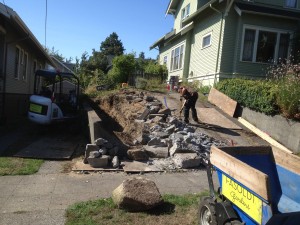
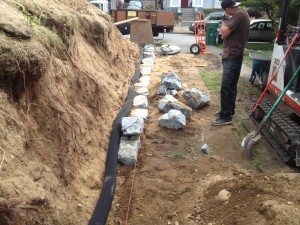
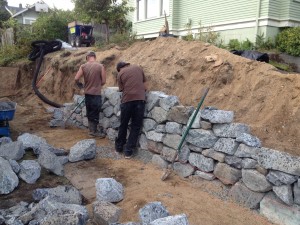
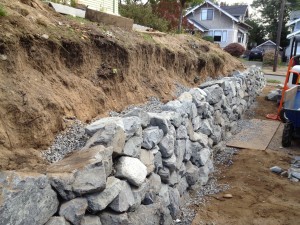
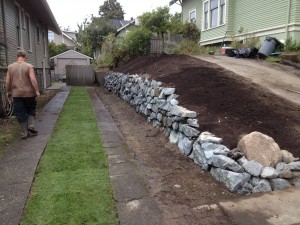
Aaron S
Posted at 13:11h, 02 OctoberNicely done indeed!
Nashville SEO
Posted at 02:53h, 19 JanuaryAwesome work. I enjoy tinkering in my yard and if I had enough self-confidence, I’d quit my municipal job and seek my fate in working the landscape construction trades. You must be in excellent physical condition, really fit both in stature and in your ability to mentally organize the workload. This project turned out well.